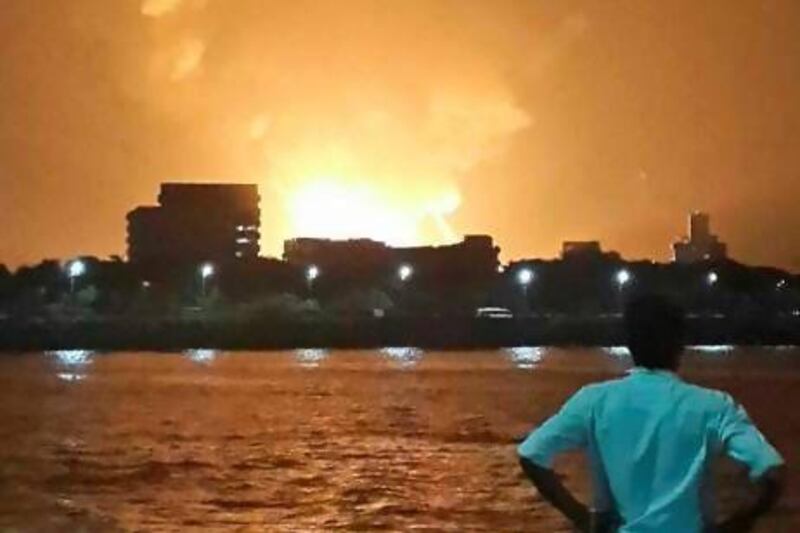MUMBAI // Divers last night were struggling to reach 18 sailors feared killed after twin explosions and a resulting fire sank an Indian navy submarine.
The INS Sindhurakshak was berthed at the naval dockyard in southern Mumbai when the explosion occurred just after midnight yesterday, trapping the sailors inside. The explosion sent a massive ball of flame into the night sky.
Military officials announced a four-week inquiry to try to establish the cause of one of the worst accidents in the Indian navy's history.
"In naval disasters of this kind, the casualties often are 100 per cent, but we are hoping for the best and preparing for the worst," said D K Joshi, the navy's chief admiral.
No reason was given for the explosion, which occurred in the front half of the submarine where its torpedoes are housed.
"We do not rule out the possibility of sabotage but it seems unlikely," Admiral Joshi said.
Rescue teams took nearly four hours to put out the blaze. Yesterday only a portion of the craft was visible above the surface of the water.
PS Rahande, the deputy chief fire officer for Mumbai, was on his way home when he saw and felt the blast.
"Immediately I called up my control room," Mr Rahande told The National. "Then there was a second blast. [Despite] all my experience, I didn't know what had happened over there. It was pretty loud. It was kind of a mushroom fireball."
Admiral Joshi confirmed that there were two explosions - first a small one, which triggered the larger one.
"While fuel, hydrogen, ammunition and explosives are on board, there are also safeties built in," he said. "Fire is not supposed to happen but quite obviously the safety mechanisms have not functioned."
Navy divers sent to rescue survivors were initially unable to enter the wrecked submarine. Later, they managed to open one of its hatches but were hampered by poor visibility.
"I am saddened by those navy personnel who lost their lives in the service of the country," said AK Antony, the Indian defence minister. "It is a great tragedy for the navy."
Three crew members stationed outside the submarine were injured in the explosion. Another submarine, INS Sindhuratna, which was berthed alongside the Sindhurakshak, received some damage.
The Sindhurakshak, a 2,000-tonne Russian-made diesel-powered submarine, is 16 years old and one of the Indian navy's 14 submarines. It had recently returned from a two-and-a-half-year refit in Russia and was expected to serve at least another 10 years.
It had an accident in 2010 when an explosion in its battery compartment, fuelled by a leaking hydrogen valve, started a fire and killed one sailor.
As a relatively old-model submarine, it did not have the escape pods that are common in more modern designs, said Sushant K Singh, a defence policy fellow at the Takshashila Institution, an independent think tank.
"Even during refittings, it isn't possible to add this kind of feature because it involves changing the structure of the submarine itself," Mr Singh said.
Russian-made submarines have had malfunctions in the past, most famously during the explosion on board the nuclear submarine Kursk, which sank in the Barents Sea in 2000, killing all its 118 sailors.
"From an Indian perspective, though, we are constrained often to buy defence equipment from Russia, because they will sell technology to India that other countries will not," Mr Singh said.
Russia has a long history of military ties with India and is thus more liberal with the technology it shares.
The Indian navy is moving fast towards indigenising its fleet, Mr Singh said, and, apart from one vessel, every new ship or submarine will be constructed at home.
"But most of the technology is still Russian," he said. "Even the high-grade steel that is used in aircraft carriers, for example, is made in India but with Russian technology."
The Sindhurakshak explosion came on the eve of India's independence day and during an otherwise proud week for the navy.
On Saturday, in what the Indian prime minister, Manmohan Singh, called a "giant stride" forward for India, the navy announced that it would soon begin sea trials for its first home-built nuclear submarine.
On Monday, the navy revealed its first aircraft carrier constructed in India - the 40,000-tonne, US$5 billion (Dh18.37bn) INS Vikrant, which will enter full service in 2018. Only Britain, France, the United States and Russia have designed and built their own aircraft carriers.
[ ssubramanian@thenational.ae ]
* Samanth Subramanian reported from New Delhi
twitter: For breaking news from the Gulf, the Middle East and around the globe follow The National World. Follow us





